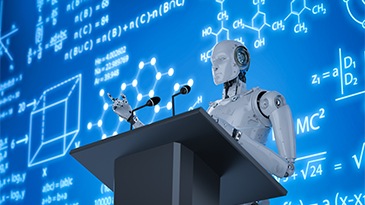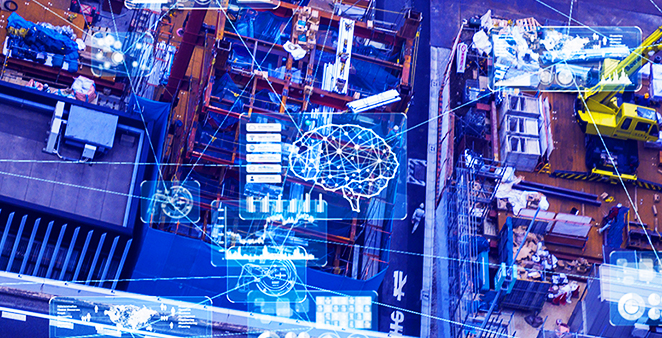In the current climate (and with uncertainty ahead), it’s a good time to take a closer look at how you can rapidly adapt and accelerate your digital transformation strategy. With remote collaboration, operational agility and autonomous production becoming ever more critical to business continuity, the potential impact of Industrial AI has never been more evident — and it’s a topic that is top-of-mind for many executives.
AI is a transformational technology, but it is also complex, multi-faceted and rapidly evolving. As such, in order to be adopted and applied, it requires diverse functions across an organization to operate interdependently. In fact, there is a growing need for organizations to assess their Industrial AI readiness and examine a framework for organizational preparedness that goes beyond data and technology.
The Industrial AI Readiness Checklist
For most industrial organizations, the trouble isn’t how to get started with AI, but understanding where to start. While data may seem like the most practical area to “get ready” before the organization adopts AI, it needs to be purposefully guided by key skills, business goals and much more. For executives in capital-intensive industries, we have distilled their maturity assessment down to the five dimensions in our Industrial AI Readiness Checklist.
1. Strategy
The first dimension of Strategy can be described as the planning and alignment of AI into enterprise-wide business goals, data objectives, high-value use cases and measurable KPIs. The outcome is a clear action plan that roadmaps the desired levels of Industrial AI readiness in the organization.
In this way, AI becomes an augmentation, not just an add-on, to the enterprise’s digital transformation strategy. This is critical in enabling organizations to:
- Embed data-driven thinking into their fabric
- Reconcile the leadership mandate with grassroots support
- Benefit from traverse impact across every function
According to the AI: Built to Scale study by Accenture, nearly 69% of executives in industrial organizations acknowledge they know how to pilot, but they struggle to scale their AI strategy across the enterprise.
While exploring and identifying AI-enabled use cases may be intriguing, the starting point of any organizational strategy is never the technology. It begins with identifying the business problems, corporate objectives and strategic goals.
2. People
This dimension refers to the mindset, roles and skills required to develop, deploy and deliver AI-enabled initiatives internal and external to the enterprise. Even the most innovative AI solutions will not be effective if people are not organized and motivated to use them.
In this area, enterprises need to align leadership, company culture and change management to ensure people are ready, willing and able to use AI. For people to successfully build and work with AI solutions, there needs to be:
- Business and technical training
- Continuous job support
- Meaningful inclusion in the strategy and process of developing and deploying AI solutions
The McKinsey Global AI Survey found that a majority of companies are preparing for AI-related workforce changes, with 83% of respondents expecting at least some of their workforce to be retrained in the next three years because of AI adoption.
3. Data
With no industrial data, there’s no Industrial AI — but how much data? How frequent? How clean? These questions need to be supported by an overarching industrial data strategy.
Furthermore, different use cases and AI techniques require different types and amounts of data. Our previous blog describes the different ways a machine can learn. Under this dimension, we focus on the pipeline of industrial data that enables the training, inferencing, quality and applicability of AI across the Industrial AI solutions.
Today, the main challenge for most industrial organizations is not a lack of data, but a lack of accessible and useful data for the industrial AI solutions they want to implement. Another key gap is the lack of a scalable data infrastructure to power industrial AI models from training to productization.
4. Infrastructure
This area refers to the tools, infrastructure and workflows for powering Industrial AI across the solution lifecycle. It also covers the software, hardware and enterprise architecture needed to productize AI in industrial environments, including broader collaboration between development, data science and infrastructure capabilities such as CloudOps, DevOps, MLOps and others. This dimension is critical to helping organizations mature beyond sporadic AI proof-of-concepts to an enterprise-wide Industrial AI strategy.
With the rapid convergence of IT and OT, companies need a well-defined industrial infrastructure strategy to:
- Significantly reduce implementation risks and accelerate time-to-market
- Gain operational flexibility and scale to future-proof AI investments
- Harmonize the AI model lifecycle across various Industrial AI applications
According to Deloitte’s recent article on the state of AI in the enterprise, the top initiative cited by companies for increasing competitive advantage from AI is “modernizing our data infrastructure for AI” (chosen by 20% of companies surveyed).
5. Ethics & Governance
Trust and transparency must infuse the Industrial AI strategy across policies, procedures and organizational structures to ensure safe, responsible and ethical use of AI. Clear communication and process documentation are critical to mitigate the risks of AI’s complexity and (relative) autonomy. (You can read more on the importance of explainable AI here.)
Like understanding the benefits, all stakeholders must have alignment on the limitations of AI. In fact, early successes show that the sum of human + AI is greater than either alone. This further reinforces the premise of Industrial AI, which combines data science and AI with software and domain expertise to deliver comprehensive and sustainable business outcomes.
You can learn more about how Industrial AI is enabling the next generation of smart software solutions in our latest executive brief, The Self-Optimizing Plant: A New Era of Autonomy, Powered by Industrial AI.






Leave A Comment